Health Economics Report: Cost-Benefit Analysis of Lymphoma Treatment
VerifiedAdded on 2023/04/21
|9
|2107
|405
Report
AI Summary
This report delves into the application of health economics in the context of lymphoma treatment, specifically comparing nano-surgery with phage therapy for leukemia. The study begins by defining health economics and its role in healthcare decision-making, emphasizing the importance of economic tools in optimizing treatment plans. It presents an in-depth analysis of the two treatment proposals, evaluating their costs, benefits, and operational aspects. The report highlights the determinants of health economics, including treatment costs, consumer income, and demand for healthcare services. Economic evaluation tools, such as cost-benefit analysis and input-output analysis, are employed to assess the effectiveness of each treatment option. The report concludes by justifying the selection of nano-surgery for lymphoma treatment, based on its cost-effectiveness, higher patient acceptance, and favorable mortality rates compared to phage therapy. The decision-making process is outlined, providing a framework for healthcare facilities to choose the most suitable and efficient treatment approach.
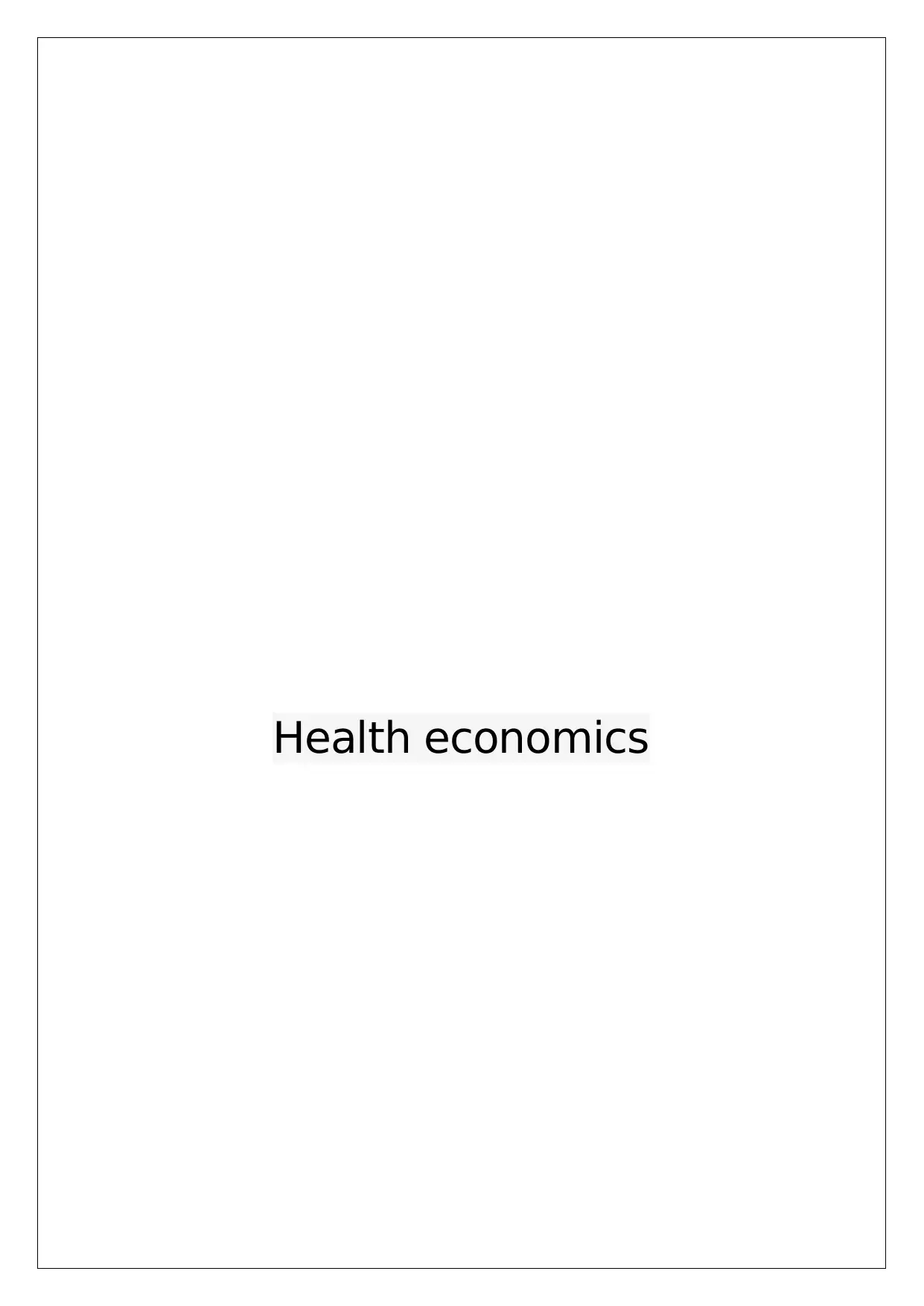
Health economics
Paraphrase This Document
Need a fresh take? Get an instant paraphrase of this document with our AI Paraphraser

Table of Contents
Introduction................................................................................................................................2
Analysis......................................................................................................................................2
Conclusion..................................................................................................................................6
Reference List............................................................................................................................7
1 | P a g e
Introduction................................................................................................................................2
Analysis......................................................................................................................................2
Conclusion..................................................................................................................................6
Reference List............................................................................................................................7
1 | P a g e
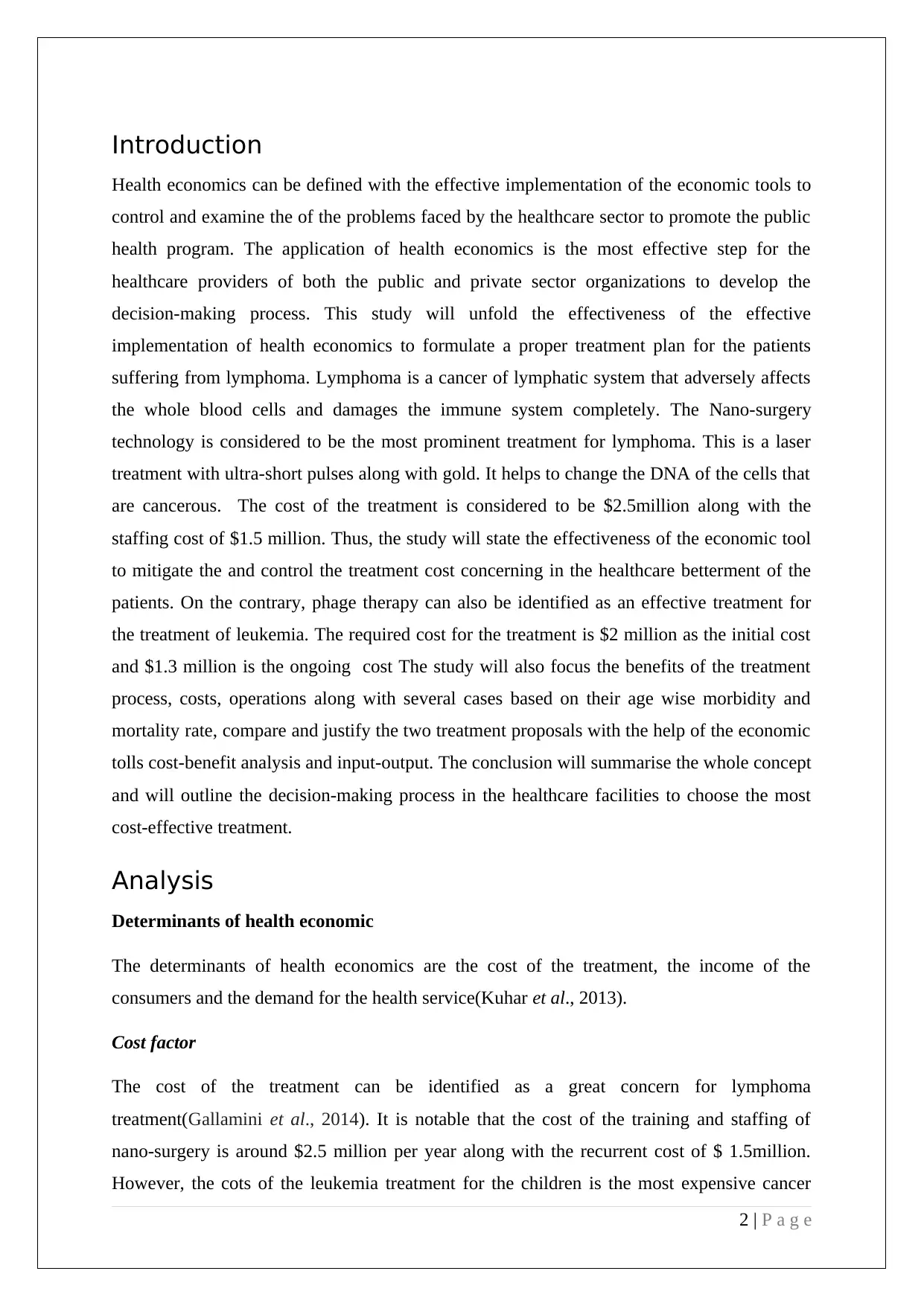
Introduction
Health economics can be defined with the effective implementation of the economic tools to
control and examine the of the problems faced by the healthcare sector to promote the public
health program. The application of health economics is the most effective step for the
healthcare providers of both the public and private sector organizations to develop the
decision-making process. This study will unfold the effectiveness of the effective
implementation of health economics to formulate a proper treatment plan for the patients
suffering from lymphoma. Lymphoma is a cancer of lymphatic system that adversely affects
the whole blood cells and damages the immune system completely. The Nano-surgery
technology is considered to be the most prominent treatment for lymphoma. This is a laser
treatment with ultra-short pulses along with gold. It helps to change the DNA of the cells that
are cancerous. The cost of the treatment is considered to be $2.5million along with the
staffing cost of $1.5 million. Thus, the study will state the effectiveness of the economic tool
to mitigate the and control the treatment cost concerning in the healthcare betterment of the
patients. On the contrary, phage therapy can also be identified as an effective treatment for
the treatment of leukemia. The required cost for the treatment is $2 million as the initial cost
and $1.3 million is the ongoing cost The study will also focus the benefits of the treatment
process, costs, operations along with several cases based on their age wise morbidity and
mortality rate, compare and justify the two treatment proposals with the help of the economic
tolls cost-benefit analysis and input-output. The conclusion will summarise the whole concept
and will outline the decision-making process in the healthcare facilities to choose the most
cost-effective treatment.
Analysis
Determinants of health economic
The determinants of health economics are the cost of the treatment, the income of the
consumers and the demand for the health service(Kuhar et al., 2013).
Cost factor
The cost of the treatment can be identified as a great concern for lymphoma
treatment(Gallamini et al., 2014). It is notable that the cost of the training and staffing of
nano-surgery is around $2.5 million per year along with the recurrent cost of $ 1.5million.
However, the cots of the leukemia treatment for the children is the most expensive cancer
2 | P a g e
Health economics can be defined with the effective implementation of the economic tools to
control and examine the of the problems faced by the healthcare sector to promote the public
health program. The application of health economics is the most effective step for the
healthcare providers of both the public and private sector organizations to develop the
decision-making process. This study will unfold the effectiveness of the effective
implementation of health economics to formulate a proper treatment plan for the patients
suffering from lymphoma. Lymphoma is a cancer of lymphatic system that adversely affects
the whole blood cells and damages the immune system completely. The Nano-surgery
technology is considered to be the most prominent treatment for lymphoma. This is a laser
treatment with ultra-short pulses along with gold. It helps to change the DNA of the cells that
are cancerous. The cost of the treatment is considered to be $2.5million along with the
staffing cost of $1.5 million. Thus, the study will state the effectiveness of the economic tool
to mitigate the and control the treatment cost concerning in the healthcare betterment of the
patients. On the contrary, phage therapy can also be identified as an effective treatment for
the treatment of leukemia. The required cost for the treatment is $2 million as the initial cost
and $1.3 million is the ongoing cost The study will also focus the benefits of the treatment
process, costs, operations along with several cases based on their age wise morbidity and
mortality rate, compare and justify the two treatment proposals with the help of the economic
tolls cost-benefit analysis and input-output. The conclusion will summarise the whole concept
and will outline the decision-making process in the healthcare facilities to choose the most
cost-effective treatment.
Analysis
Determinants of health economic
The determinants of health economics are the cost of the treatment, the income of the
consumers and the demand for the health service(Kuhar et al., 2013).
Cost factor
The cost of the treatment can be identified as a great concern for lymphoma
treatment(Gallamini et al., 2014). It is notable that the cost of the training and staffing of
nano-surgery is around $2.5 million per year along with the recurrent cost of $ 1.5million.
However, the cots of the leukemia treatment for the children is the most expensive cancer
2 | P a g e
⊘ This is a preview!⊘
Do you want full access?
Subscribe today to unlock all pages.

Trusted by 1+ million students worldwide
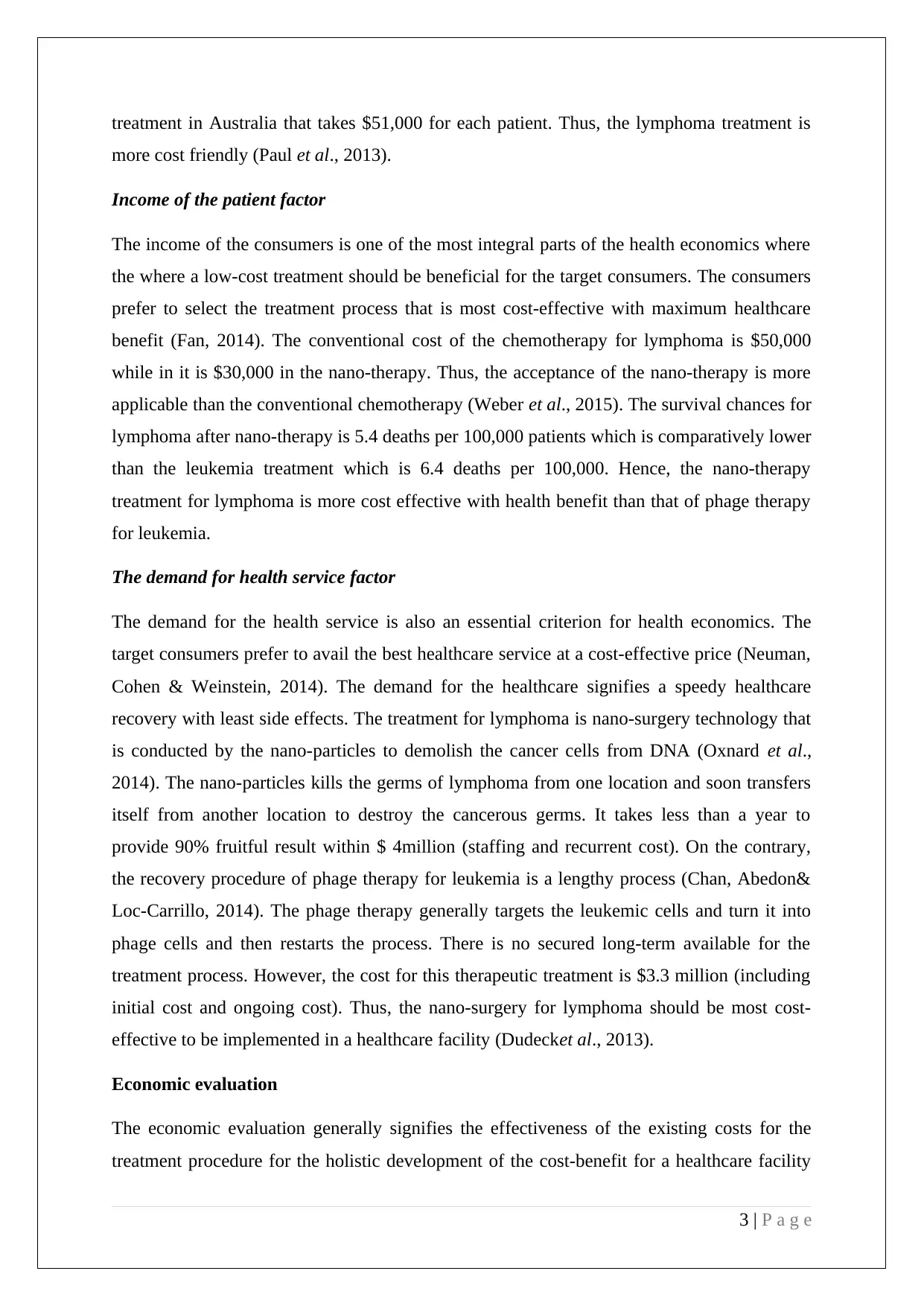
treatment in Australia that takes $51,000 for each patient. Thus, the lymphoma treatment is
more cost friendly (Paul et al., 2013).
Income of the patient factor
The income of the consumers is one of the most integral parts of the health economics where
the where a low-cost treatment should be beneficial for the target consumers. The consumers
prefer to select the treatment process that is most cost-effective with maximum healthcare
benefit (Fan, 2014). The conventional cost of the chemotherapy for lymphoma is $50,000
while in it is $30,000 in the nano-therapy. Thus, the acceptance of the nano-therapy is more
applicable than the conventional chemotherapy (Weber et al., 2015). The survival chances for
lymphoma after nano-therapy is 5.4 deaths per 100,000 patients which is comparatively lower
than the leukemia treatment which is 6.4 deaths per 100,000. Hence, the nano-therapy
treatment for lymphoma is more cost effective with health benefit than that of phage therapy
for leukemia.
The demand for health service factor
The demand for the health service is also an essential criterion for health economics. The
target consumers prefer to avail the best healthcare service at a cost-effective price (Neuman,
Cohen & Weinstein, 2014). The demand for the healthcare signifies a speedy healthcare
recovery with least side effects. The treatment for lymphoma is nano-surgery technology that
is conducted by the nano-particles to demolish the cancer cells from DNA (Oxnard et al.,
2014). The nano-particles kills the germs of lymphoma from one location and soon transfers
itself from another location to destroy the cancerous germs. It takes less than a year to
provide 90% fruitful result within $ 4million (staffing and recurrent cost). On the contrary,
the recovery procedure of phage therapy for leukemia is a lengthy process (Chan, Abedon&
Loc-Carrillo, 2014). The phage therapy generally targets the leukemic cells and turn it into
phage cells and then restarts the process. There is no secured long-term available for the
treatment process. However, the cost for this therapeutic treatment is $3.3 million (including
initial cost and ongoing cost). Thus, the nano-surgery for lymphoma should be most cost-
effective to be implemented in a healthcare facility (Dudecket al., 2013).
Economic evaluation
The economic evaluation generally signifies the effectiveness of the existing costs for the
treatment procedure for the holistic development of the cost-benefit for a healthcare facility
3 | P a g e
more cost friendly (Paul et al., 2013).
Income of the patient factor
The income of the consumers is one of the most integral parts of the health economics where
the where a low-cost treatment should be beneficial for the target consumers. The consumers
prefer to select the treatment process that is most cost-effective with maximum healthcare
benefit (Fan, 2014). The conventional cost of the chemotherapy for lymphoma is $50,000
while in it is $30,000 in the nano-therapy. Thus, the acceptance of the nano-therapy is more
applicable than the conventional chemotherapy (Weber et al., 2015). The survival chances for
lymphoma after nano-therapy is 5.4 deaths per 100,000 patients which is comparatively lower
than the leukemia treatment which is 6.4 deaths per 100,000. Hence, the nano-therapy
treatment for lymphoma is more cost effective with health benefit than that of phage therapy
for leukemia.
The demand for health service factor
The demand for the health service is also an essential criterion for health economics. The
target consumers prefer to avail the best healthcare service at a cost-effective price (Neuman,
Cohen & Weinstein, 2014). The demand for the healthcare signifies a speedy healthcare
recovery with least side effects. The treatment for lymphoma is nano-surgery technology that
is conducted by the nano-particles to demolish the cancer cells from DNA (Oxnard et al.,
2014). The nano-particles kills the germs of lymphoma from one location and soon transfers
itself from another location to destroy the cancerous germs. It takes less than a year to
provide 90% fruitful result within $ 4million (staffing and recurrent cost). On the contrary,
the recovery procedure of phage therapy for leukemia is a lengthy process (Chan, Abedon&
Loc-Carrillo, 2014). The phage therapy generally targets the leukemic cells and turn it into
phage cells and then restarts the process. There is no secured long-term available for the
treatment process. However, the cost for this therapeutic treatment is $3.3 million (including
initial cost and ongoing cost). Thus, the nano-surgery for lymphoma should be most cost-
effective to be implemented in a healthcare facility (Dudecket al., 2013).
Economic evaluation
The economic evaluation generally signifies the effectiveness of the existing costs for the
treatment procedure for the holistic development of the cost-benefit for a healthcare facility
3 | P a g e
Paraphrase This Document
Need a fresh take? Get an instant paraphrase of this document with our AI Paraphraser
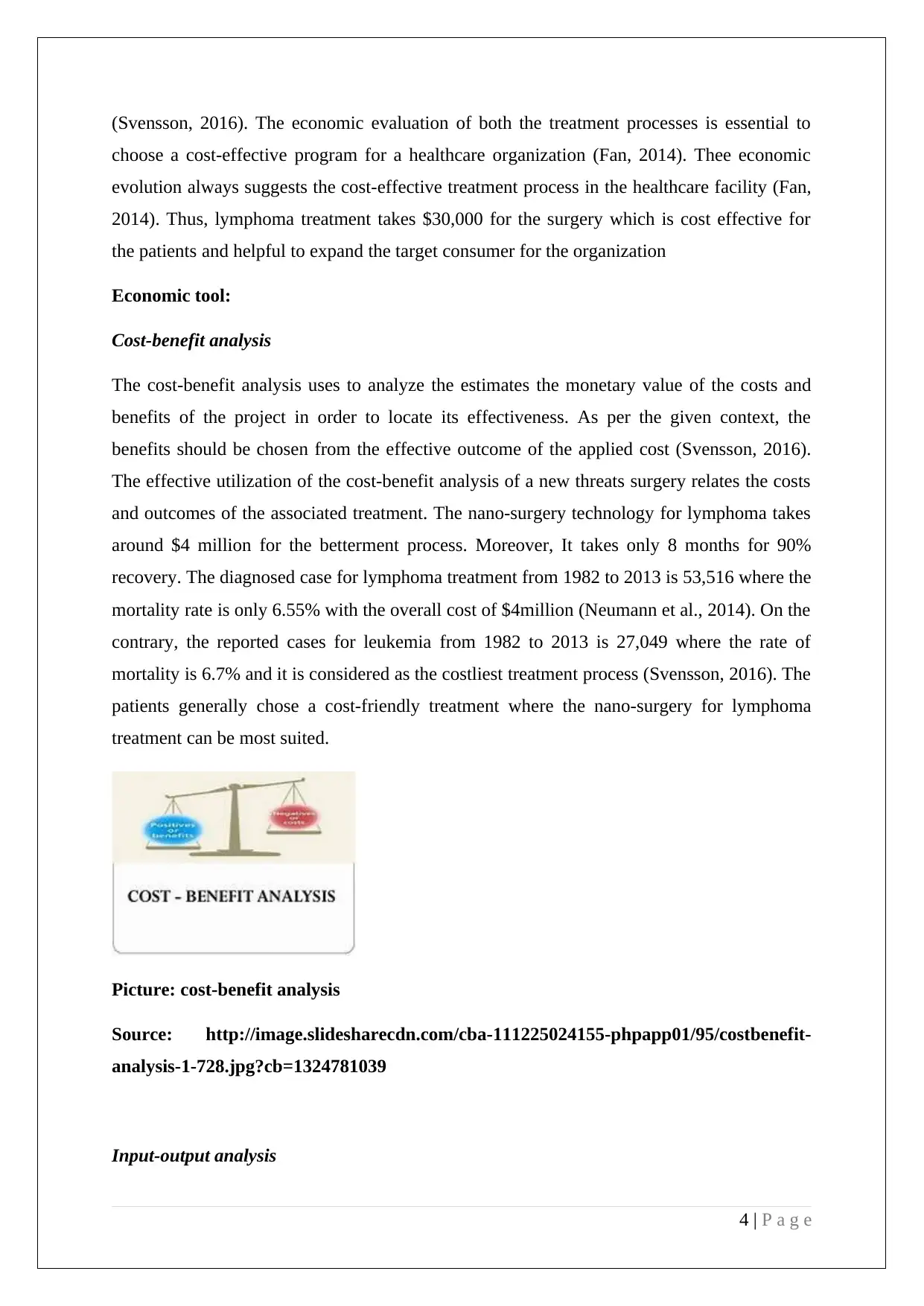
(Svensson, 2016). The economic evaluation of both the treatment processes is essential to
choose a cost-effective program for a healthcare organization (Fan, 2014). Thee economic
evolution always suggests the cost-effective treatment process in the healthcare facility (Fan,
2014). Thus, lymphoma treatment takes $30,000 for the surgery which is cost effective for
the patients and helpful to expand the target consumer for the organization
Economic tool:
Cost-benefit analysis
The cost-benefit analysis uses to analyze the estimates the monetary value of the costs and
benefits of the project in order to locate its effectiveness. As per the given context, the
benefits should be chosen from the effective outcome of the applied cost (Svensson, 2016).
The effective utilization of the cost-benefit analysis of a new threats surgery relates the costs
and outcomes of the associated treatment. The nano-surgery technology for lymphoma takes
around $4 million for the betterment process. Moreover, It takes only 8 months for 90%
recovery. The diagnosed case for lymphoma treatment from 1982 to 2013 is 53,516 where the
mortality rate is only 6.55% with the overall cost of $4million (Neumann et al., 2014). On the
contrary, the reported cases for leukemia from 1982 to 2013 is 27,049 where the rate of
mortality is 6.7% and it is considered as the costliest treatment process (Svensson, 2016). The
patients generally chose a cost-friendly treatment where the nano-surgery for lymphoma
treatment can be most suited.
Picture: cost-benefit analysis
Source: http://image.slidesharecdn.com/cba-111225024155-phpapp01/95/costbenefit-
analysis-1-728.jpg?cb=1324781039
Input-output analysis
4 | P a g e
choose a cost-effective program for a healthcare organization (Fan, 2014). Thee economic
evolution always suggests the cost-effective treatment process in the healthcare facility (Fan,
2014). Thus, lymphoma treatment takes $30,000 for the surgery which is cost effective for
the patients and helpful to expand the target consumer for the organization
Economic tool:
Cost-benefit analysis
The cost-benefit analysis uses to analyze the estimates the monetary value of the costs and
benefits of the project in order to locate its effectiveness. As per the given context, the
benefits should be chosen from the effective outcome of the applied cost (Svensson, 2016).
The effective utilization of the cost-benefit analysis of a new threats surgery relates the costs
and outcomes of the associated treatment. The nano-surgery technology for lymphoma takes
around $4 million for the betterment process. Moreover, It takes only 8 months for 90%
recovery. The diagnosed case for lymphoma treatment from 1982 to 2013 is 53,516 where the
mortality rate is only 6.55% with the overall cost of $4million (Neumann et al., 2014). On the
contrary, the reported cases for leukemia from 1982 to 2013 is 27,049 where the rate of
mortality is 6.7% and it is considered as the costliest treatment process (Svensson, 2016). The
patients generally chose a cost-friendly treatment where the nano-surgery for lymphoma
treatment can be most suited.
Picture: cost-benefit analysis
Source: http://image.slidesharecdn.com/cba-111225024155-phpapp01/95/costbenefit-
analysis-1-728.jpg?cb=1324781039
Input-output analysis
4 | P a g e
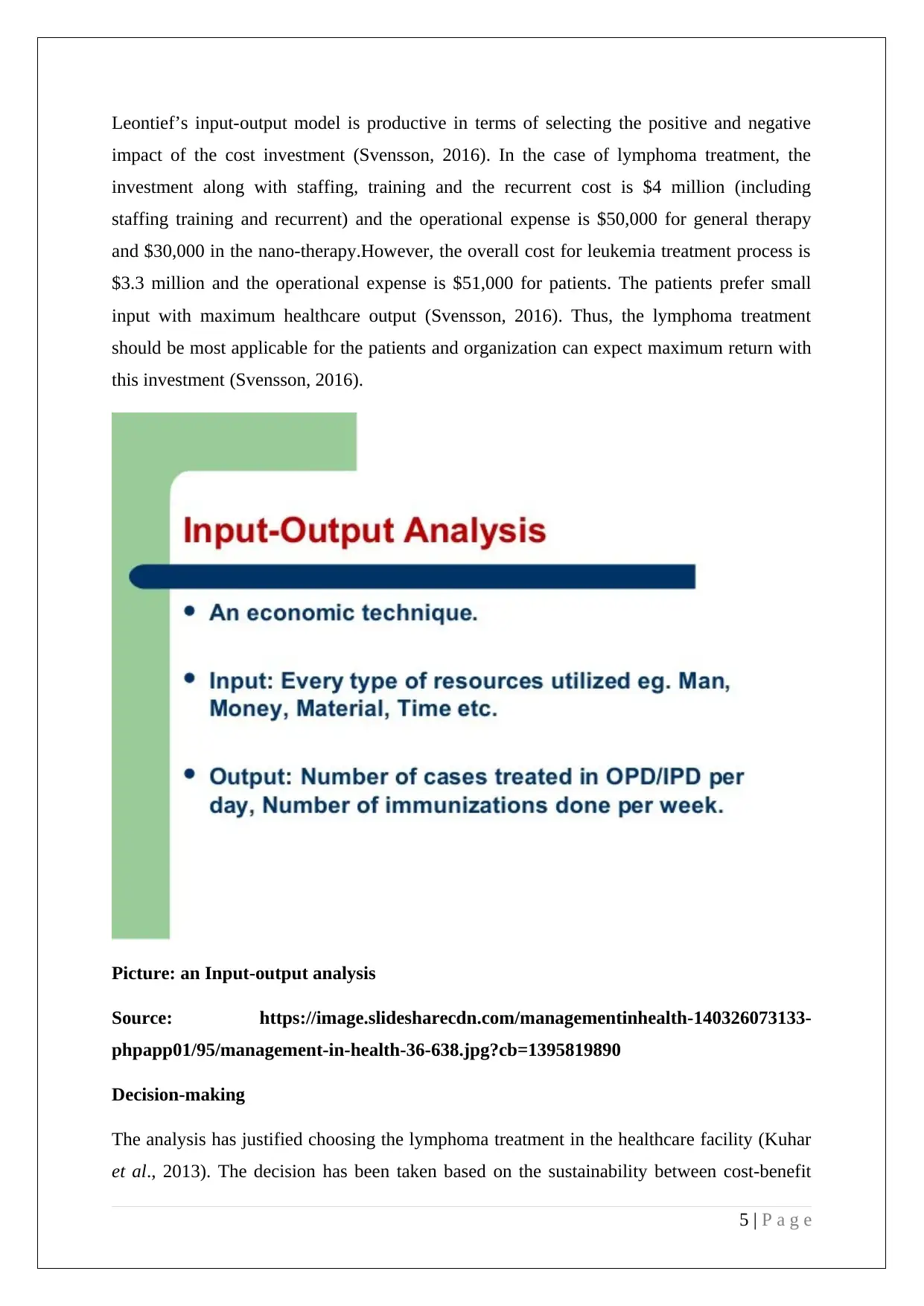
Leontief’s input-output model is productive in terms of selecting the positive and negative
impact of the cost investment (Svensson, 2016). In the case of lymphoma treatment, the
investment along with staffing, training and the recurrent cost is $4 million (including
staffing training and recurrent) and the operational expense is $50,000 for general therapy
and $30,000 in the nano-therapy.However, the overall cost for leukemia treatment process is
$3.3 million and the operational expense is $51,000 for patients. The patients prefer small
input with maximum healthcare output (Svensson, 2016). Thus, the lymphoma treatment
should be most applicable for the patients and organization can expect maximum return with
this investment (Svensson, 2016).
Picture: an Input-output analysis
Source: https://image.slidesharecdn.com/managementinhealth-140326073133-
phpapp01/95/management-in-health-36-638.jpg?cb=1395819890
Decision-making
The analysis has justified choosing the lymphoma treatment in the healthcare facility (Kuhar
et al., 2013). The decision has been taken based on the sustainability between cost-benefit
5 | P a g e
impact of the cost investment (Svensson, 2016). In the case of lymphoma treatment, the
investment along with staffing, training and the recurrent cost is $4 million (including
staffing training and recurrent) and the operational expense is $50,000 for general therapy
and $30,000 in the nano-therapy.However, the overall cost for leukemia treatment process is
$3.3 million and the operational expense is $51,000 for patients. The patients prefer small
input with maximum healthcare output (Svensson, 2016). Thus, the lymphoma treatment
should be most applicable for the patients and organization can expect maximum return with
this investment (Svensson, 2016).
Picture: an Input-output analysis
Source: https://image.slidesharecdn.com/managementinhealth-140326073133-
phpapp01/95/management-in-health-36-638.jpg?cb=1395819890
Decision-making
The analysis has justified choosing the lymphoma treatment in the healthcare facility (Kuhar
et al., 2013). The decision has been taken based on the sustainability between cost-benefit
5 | P a g e
⊘ This is a preview!⊘
Do you want full access?
Subscribe today to unlock all pages.

Trusted by 1+ million students worldwide
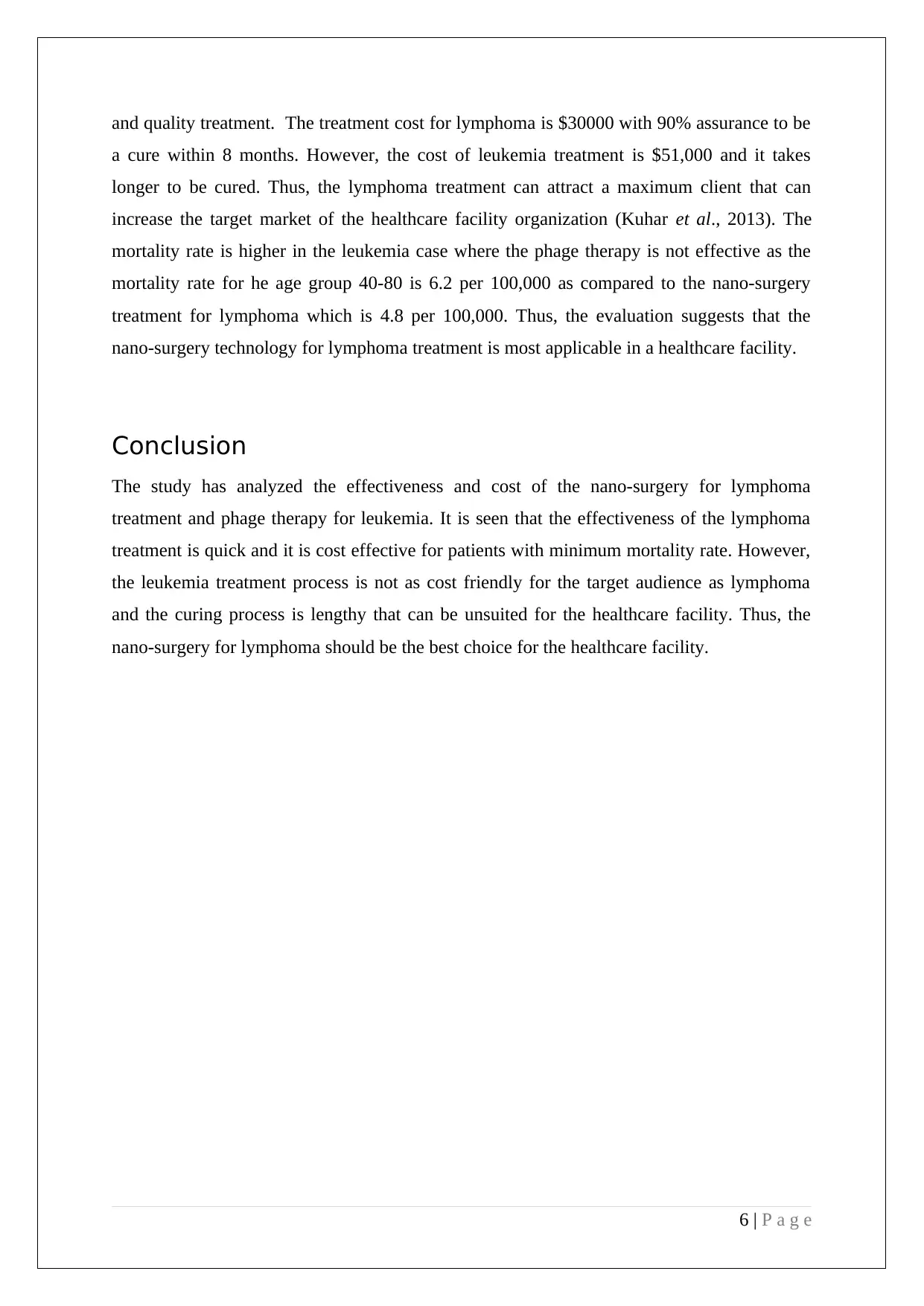
and quality treatment. The treatment cost for lymphoma is $30000 with 90% assurance to be
a cure within 8 months. However, the cost of leukemia treatment is $51,000 and it takes
longer to be cured. Thus, the lymphoma treatment can attract a maximum client that can
increase the target market of the healthcare facility organization (Kuhar et al., 2013). The
mortality rate is higher in the leukemia case where the phage therapy is not effective as the
mortality rate for he age group 40-80 is 6.2 per 100,000 as compared to the nano-surgery
treatment for lymphoma which is 4.8 per 100,000. Thus, the evaluation suggests that the
nano-surgery technology for lymphoma treatment is most applicable in a healthcare facility.
Conclusion
The study has analyzed the effectiveness and cost of the nano-surgery for lymphoma
treatment and phage therapy for leukemia. It is seen that the effectiveness of the lymphoma
treatment is quick and it is cost effective for patients with minimum mortality rate. However,
the leukemia treatment process is not as cost friendly for the target audience as lymphoma
and the curing process is lengthy that can be unsuited for the healthcare facility. Thus, the
nano-surgery for lymphoma should be the best choice for the healthcare facility.
6 | P a g e
a cure within 8 months. However, the cost of leukemia treatment is $51,000 and it takes
longer to be cured. Thus, the lymphoma treatment can attract a maximum client that can
increase the target market of the healthcare facility organization (Kuhar et al., 2013). The
mortality rate is higher in the leukemia case where the phage therapy is not effective as the
mortality rate for he age group 40-80 is 6.2 per 100,000 as compared to the nano-surgery
treatment for lymphoma which is 4.8 per 100,000. Thus, the evaluation suggests that the
nano-surgery technology for lymphoma treatment is most applicable in a healthcare facility.
Conclusion
The study has analyzed the effectiveness and cost of the nano-surgery for lymphoma
treatment and phage therapy for leukemia. It is seen that the effectiveness of the lymphoma
treatment is quick and it is cost effective for patients with minimum mortality rate. However,
the leukemia treatment process is not as cost friendly for the target audience as lymphoma
and the curing process is lengthy that can be unsuited for the healthcare facility. Thus, the
nano-surgery for lymphoma should be the best choice for the healthcare facility.
6 | P a g e
Paraphrase This Document
Need a fresh take? Get an instant paraphrase of this document with our AI Paraphraser
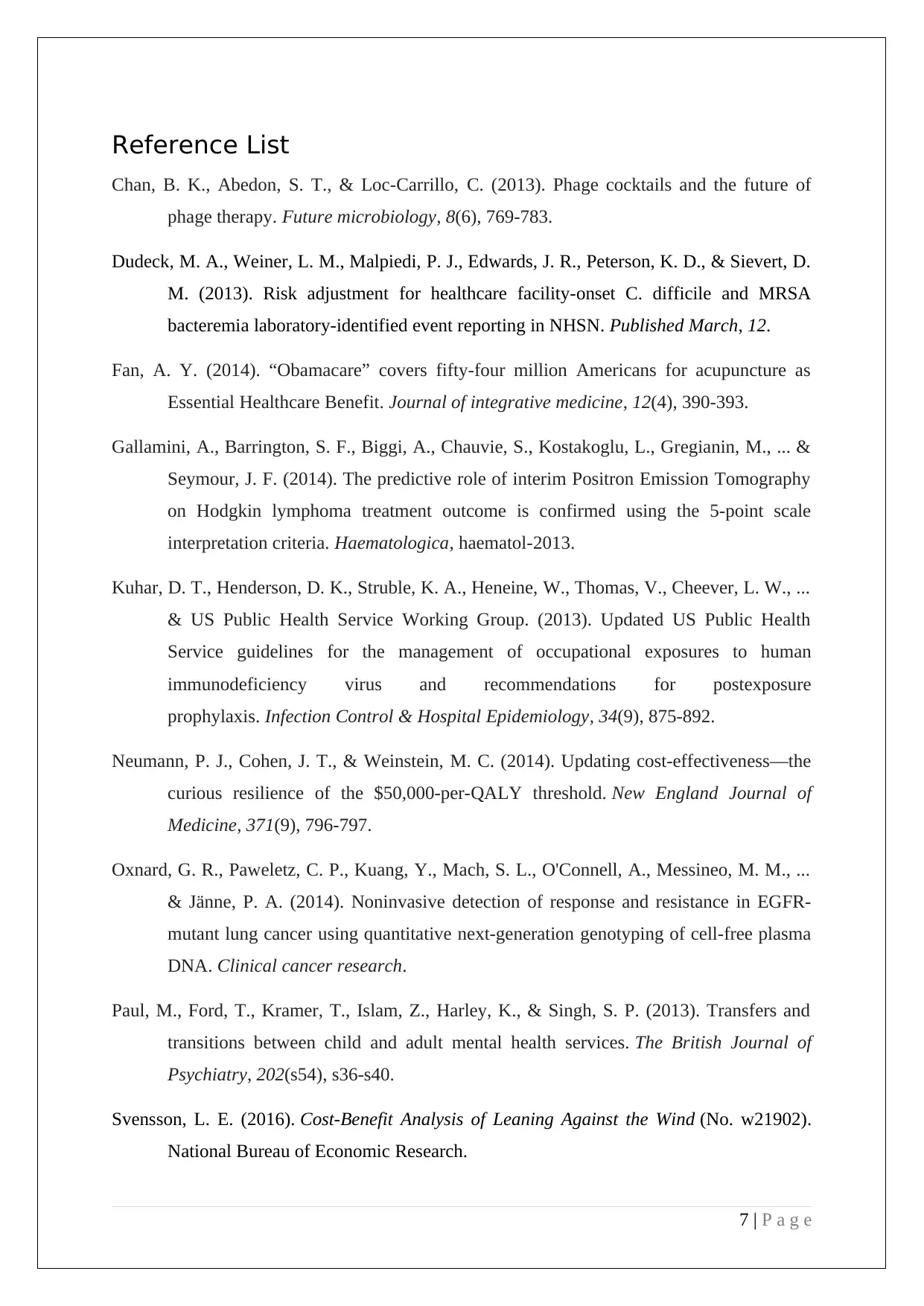
Reference List
Chan, B. K., Abedon, S. T., & Loc-Carrillo, C. (2013). Phage cocktails and the future of
phage therapy. Future microbiology, 8(6), 769-783.
Dudeck, M. A., Weiner, L. M., Malpiedi, P. J., Edwards, J. R., Peterson, K. D., & Sievert, D.
M. (2013). Risk adjustment for healthcare facility-onset C. difficile and MRSA
bacteremia laboratory-identified event reporting in NHSN. Published March, 12.
Fan, A. Y. (2014). “Obamacare” covers fifty-four million Americans for acupuncture as
Essential Healthcare Benefit. Journal of integrative medicine, 12(4), 390-393.
Gallamini, A., Barrington, S. F., Biggi, A., Chauvie, S., Kostakoglu, L., Gregianin, M., ... &
Seymour, J. F. (2014). The predictive role of interim Positron Emission Tomography
on Hodgkin lymphoma treatment outcome is confirmed using the 5-point scale
interpretation criteria. Haematologica, haematol-2013.
Kuhar, D. T., Henderson, D. K., Struble, K. A., Heneine, W., Thomas, V., Cheever, L. W., ...
& US Public Health Service Working Group. (2013). Updated US Public Health
Service guidelines for the management of occupational exposures to human
immunodeficiency virus and recommendations for postexposure
prophylaxis. Infection Control & Hospital Epidemiology, 34(9), 875-892.
Neumann, P. J., Cohen, J. T., & Weinstein, M. C. (2014). Updating cost-effectiveness—the
curious resilience of the $50,000-per-QALY threshold. New England Journal of
Medicine, 371(9), 796-797.
Oxnard, G. R., Paweletz, C. P., Kuang, Y., Mach, S. L., O'Connell, A., Messineo, M. M., ...
& Jänne, P. A. (2014). Noninvasive detection of response and resistance in EGFR-
mutant lung cancer using quantitative next-generation genotyping of cell-free plasma
DNA. Clinical cancer research.
Paul, M., Ford, T., Kramer, T., Islam, Z., Harley, K., & Singh, S. P. (2013). Transfers and
transitions between child and adult mental health services. The British Journal of
Psychiatry, 202(s54), s36-s40.
Svensson, L. E. (2016). Cost-Benefit Analysis of Leaning Against the Wind (No. w21902).
National Bureau of Economic Research.
7 | P a g e
Chan, B. K., Abedon, S. T., & Loc-Carrillo, C. (2013). Phage cocktails and the future of
phage therapy. Future microbiology, 8(6), 769-783.
Dudeck, M. A., Weiner, L. M., Malpiedi, P. J., Edwards, J. R., Peterson, K. D., & Sievert, D.
M. (2013). Risk adjustment for healthcare facility-onset C. difficile and MRSA
bacteremia laboratory-identified event reporting in NHSN. Published March, 12.
Fan, A. Y. (2014). “Obamacare” covers fifty-four million Americans for acupuncture as
Essential Healthcare Benefit. Journal of integrative medicine, 12(4), 390-393.
Gallamini, A., Barrington, S. F., Biggi, A., Chauvie, S., Kostakoglu, L., Gregianin, M., ... &
Seymour, J. F. (2014). The predictive role of interim Positron Emission Tomography
on Hodgkin lymphoma treatment outcome is confirmed using the 5-point scale
interpretation criteria. Haematologica, haematol-2013.
Kuhar, D. T., Henderson, D. K., Struble, K. A., Heneine, W., Thomas, V., Cheever, L. W., ...
& US Public Health Service Working Group. (2013). Updated US Public Health
Service guidelines for the management of occupational exposures to human
immunodeficiency virus and recommendations for postexposure
prophylaxis. Infection Control & Hospital Epidemiology, 34(9), 875-892.
Neumann, P. J., Cohen, J. T., & Weinstein, M. C. (2014). Updating cost-effectiveness—the
curious resilience of the $50,000-per-QALY threshold. New England Journal of
Medicine, 371(9), 796-797.
Oxnard, G. R., Paweletz, C. P., Kuang, Y., Mach, S. L., O'Connell, A., Messineo, M. M., ...
& Jänne, P. A. (2014). Noninvasive detection of response and resistance in EGFR-
mutant lung cancer using quantitative next-generation genotyping of cell-free plasma
DNA. Clinical cancer research.
Paul, M., Ford, T., Kramer, T., Islam, Z., Harley, K., & Singh, S. P. (2013). Transfers and
transitions between child and adult mental health services. The British Journal of
Psychiatry, 202(s54), s36-s40.
Svensson, L. E. (2016). Cost-Benefit Analysis of Leaning Against the Wind (No. w21902).
National Bureau of Economic Research.
7 | P a g e
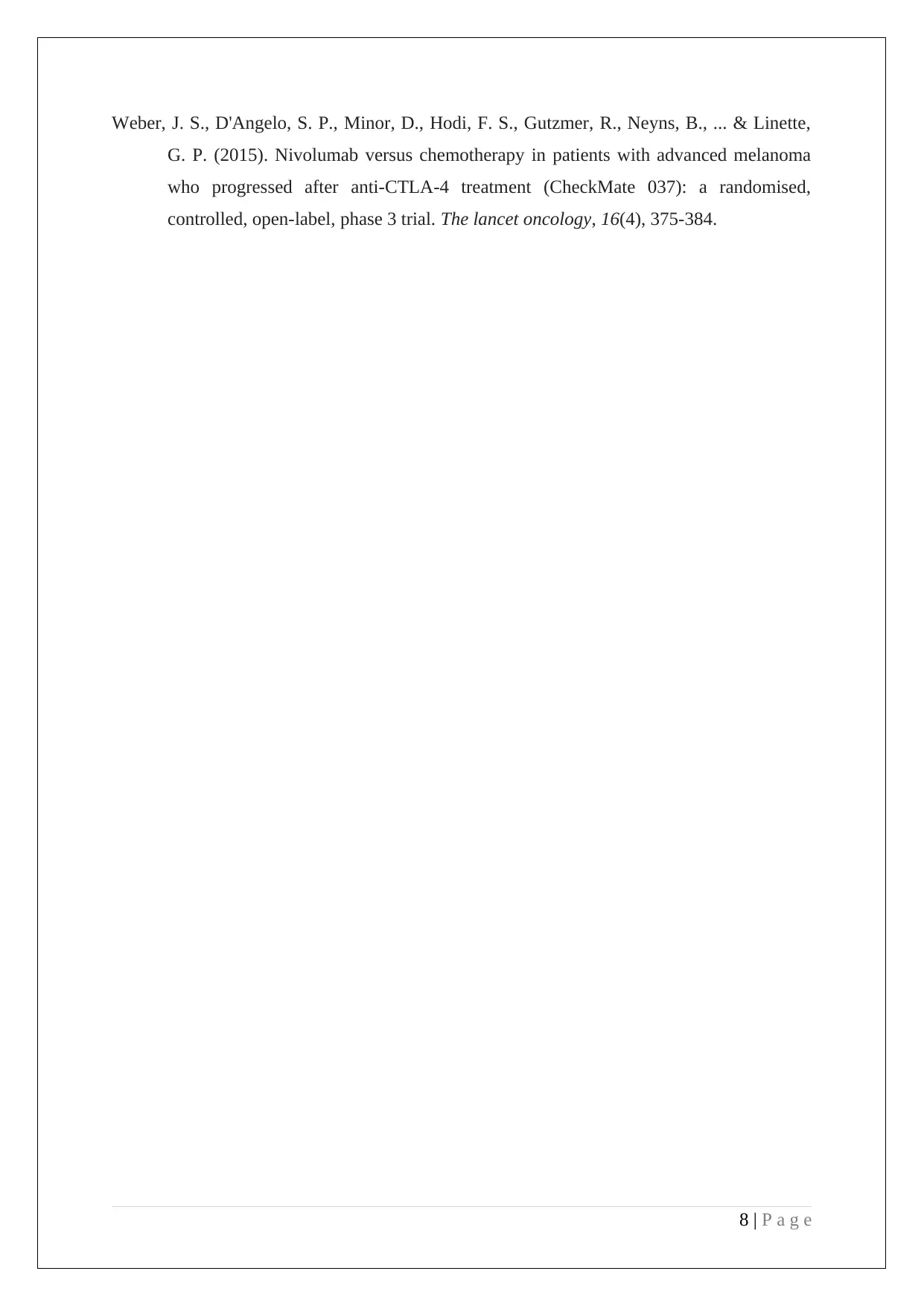
Weber, J. S., D'Angelo, S. P., Minor, D., Hodi, F. S., Gutzmer, R., Neyns, B., ... & Linette,
G. P. (2015). Nivolumab versus chemotherapy in patients with advanced melanoma
who progressed after anti-CTLA-4 treatment (CheckMate 037): a randomised,
controlled, open-label, phase 3 trial. The lancet oncology, 16(4), 375-384.
8 | P a g e
G. P. (2015). Nivolumab versus chemotherapy in patients with advanced melanoma
who progressed after anti-CTLA-4 treatment (CheckMate 037): a randomised,
controlled, open-label, phase 3 trial. The lancet oncology, 16(4), 375-384.
8 | P a g e
⊘ This is a preview!⊘
Do you want full access?
Subscribe today to unlock all pages.

Trusted by 1+ million students worldwide
1 out of 9
Related Documents
Your All-in-One AI-Powered Toolkit for Academic Success.
+13062052269
info@desklib.com
Available 24*7 on WhatsApp / Email
![[object Object]](/_next/static/media/star-bottom.7253800d.svg)
Unlock your academic potential
Copyright © 2020–2025 A2Z Services. All Rights Reserved. Developed and managed by ZUCOL.





